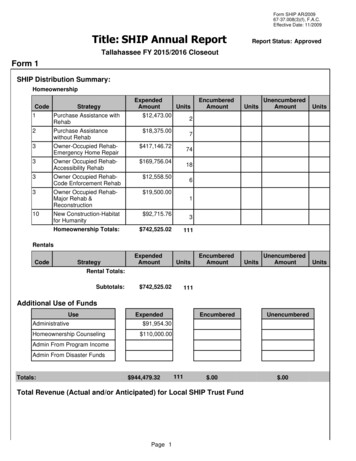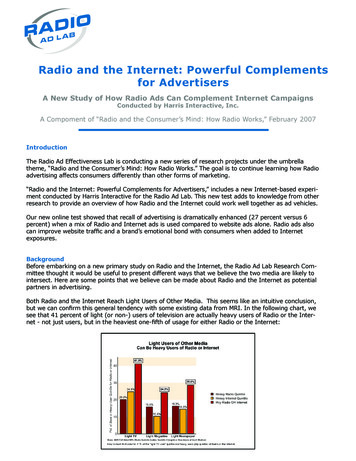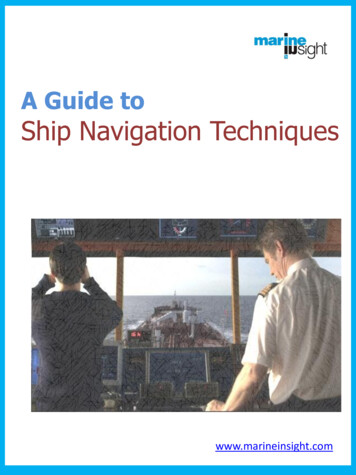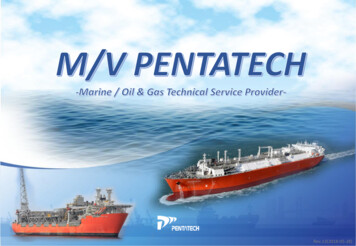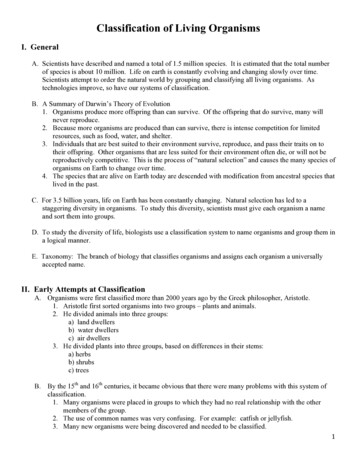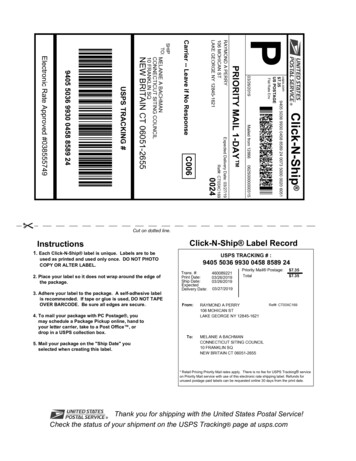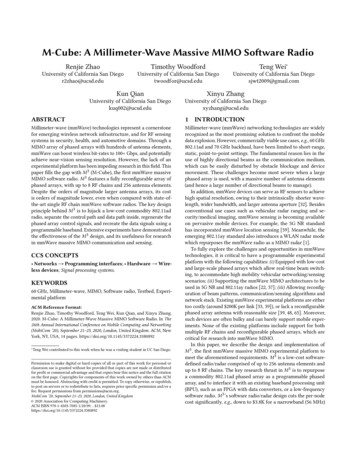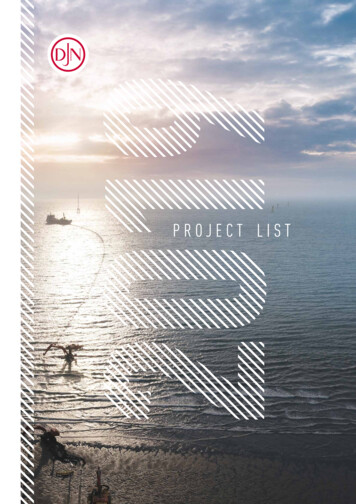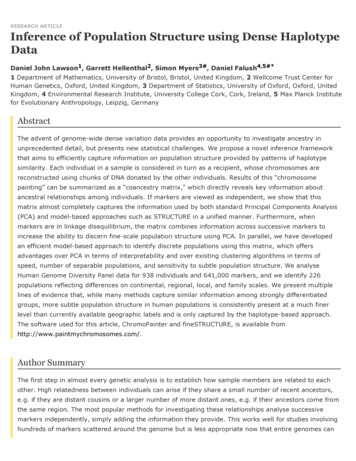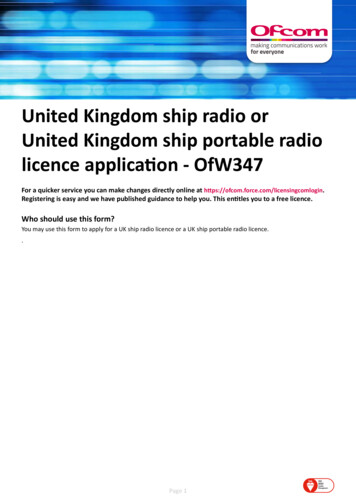
Transcription
United Kingdom ship radio orUnited Kingdom ship portable radiolicence application - OfW347For a quicker service you can make changes directly online at ing is easy and we have published guidance to help you. This entitles you to a free licence.Who should use this form?You may use this form to apply for a UK ship radio licence or a UK ship portable radio licence.Page 1
Application GuidanceConditionsHow we use your dataRegisteringPlease see Ofcom’s General Privacy Statement forfurther information about how Ofcom handles yourpersonal information and your corresponding rivacy-statementUnder the Wireless Telegraphy Act 2006, you must havea licence issued by Ofcom before you establish or useany ship radio and ship portable radio equipment.Please note that ship radio and ship portable radiolicence applicants are encouraged to register and applyfor and print their radio licences via the Ofcom websitewww.ofcom.org.uk.The information held by Ofcom will be updated asappropriate by relevant numbering records providedby Inmarsat, Accounting Authority Identification Coderecords by the (Maritime Radio) Accounting Authoritiesand EPIRP/PLB records provided by the MCA.Communication preferenceWhere possible, we send correspondence to licenseeselectronically. This is quicker for you and cheaperfor us. By applying on-line and providing youremail address, we assume that you wish to receivecorrespondence and notifications relating to WirelessTelegraphy Act licences electronically and not on paper.The information provided by Ofcom to the InternationalTelecommunications Union (ITU) and the Maritimeand Coastguard Agency (MCA) to assist in Searchand Rescue operations and to help ensure that theinformation held by the ITU and MCA is accurate andup to date. This information may also be provided byOfcom to law enforcement agencies (such as the police)for crime and taxation purposes as well as the MaritimeAdministrations MCA Channel Islands and the Isle ofMan. We will keep your information confidential andwill not disclose it to third parties, except where we arerequired to do so by law or where we have obtainedyour consent in advance.If you do not wish to receive documents electronically,you must opt out by ticking the ‘Letter’ box.Completing this formWhen completing this application please refer to thenotes and complete in dark ink in BLOCK CAPITALS.All fields are mandatory unless stated otherwise.ImportantMaritime radio transmitting radio equipment may beoperated only or under the direct supervision of theholder of the appropriate Maritime Radio Operator’sCertificate or Competence and Authority to Operate.Details of these are available from the Maritime andCoastguard Agency (MCA).Please note that in general, licensing details of shipportable radio licences are not sent to the ITU.For help contact:The radio equipment is covered by this licence mustmeet certain performance requirements as described inSection 4 of the guidance notes.PaymentPayments must include all bank charges. If Ofcom doesnot receive full payment, it will return any partial payments received.We require this information in order to carry out ourlicensing duties under the Wireless Telegraphy Act2006.OfcomFAO Spectrum LicensingPO Box 1285WarringtonWA1 9GLE-mail: spectrum.licensing@ofcom.org.ukWebsite: www.ofcom.org.uk/manage-your-licenceTelephone: 020 7981 3131Page 2
A. Application purposeA1. Please tick the relevant box:Ship radio licenceShips portable radio licenceLimited to one set of certain types of portable radio equipment (e.g. EPIRBS/PLBs), whilst not limited to use on a vessel. For use in UK terrestrial waters.Please note that licences are not transferable and in the case of a ship radio licence, a transferred or disposed of vessel mustbe treated as a ‘Surrender’ whilst a newly acquired vessel (whether new or old) must be treated as a new licence application.aaaaaaaaB. Applicant detailsB1. Customer reference numberIf you are an existing licensee, please provide your customer referencenumber and go to question B.4. If not, please complete all sections.B2. Who is the licence to be issued to?A licence can only be issued to a legal entity. Ofcom recognises the following types of entity.Please tick the relevant box:Crown BodyNHS ScotlandIndividual or Sole TraderGovernmentNon-UK Company/PLCUnincorporated AssociationIncorporated AssociationNon-UK ited Company/PLCPartnershipCommunity Interest CompanyLocal GovernmentPublic BodyRoyal CharterNHS England and WalesRegistered CharityNHS Northern IrelandReligious BodyIndividual or Sole TraderFull namePartnershipFull nameNB: For a partnership, please give the full name of one partner (who must also sign the declaration of this form and supply alist of all the full names of all the other partners in the declaration.Limited or Public Limited Company/Incorporated AssociationCompany registrationNamenumberRegistered CharityNameCharity registrationnumberIf your organisation is a registered charity, does it have asits objective, the safety of human life in an emergency?Other legal entityNameYesRegistration number(where applicable)Page 3No
B3. Licensee name and address Companies should use the registered address from http://www.companieshouse.gov.ukRegistered charities should use the address from commissionFor all other Licensees, please use your main business addressNameTrading nameAddressTel. no.MobileoptionalPostcodeFax no.optionalCountryEmailoptionalPlease indicate your communication preferenceEmailLetterB4. Licence contact name and address (where different from above)Licensing documentation and correspondence will be sent to this address.NameAddressTel. no.MobileoptionalPostcodeFax no.optionalCountryEmailoptionalPlease indicate your communication preferenceEmailLetterB5. Contact name and address for payments, billing, or account queries (where different from above)NB: This is the person who will receive invoices and reminders when payments are due. Do not include payment with this form, as you will be invoiced laterNameAddressTel. no.MobileoptionalPostcodeFax no.optionalCountryEmailoptionalPlease indicate your communication preferenceEmailPage 4Letter
B6. If you are applying via a third party (e.g. radio supplier, consultant etc.) please completethe following:NameAddressTel. no.MobileoptionalPostcodeFax no.optionalCountryEmailoptionalPlease indicate your communication preferenceEmailLetterPlease tick if you would like a copy of the licence to be sent to your third party supplierC. Vessel details (ship radio licence only)C1. Name of vesselC2. Has the vessel previously been issued with a ship radio licence?Yes: Go to question C3No: Go to question C5Unsure: Go to question C5C3. State the vessel's callsignSee ‘Ship radio guidance notes for licensing’C4. State the vessel's MMSI numberSee ‘Ship radio guidance notes for licensing’C5. Have you changed the vessel’s name?YesNoIf yes, state previous nameC6. Previous owner's name and address:NameAddressTel. no.MobileoptionalPostcodeFax no.optionalCountryEmailoptionalPage 5
C7. Indicate the intended use of the vessel Please tick the relevant box:i.e. the general classification, see ’Ship guidance notes for licensing’.Pleasure ship (code PL)Official service ship (code GV)Ship of a fishing fleet (code FV)River vessel (code NF)Merchant ship (code MM)Rescue vessel (code SV)Naval ship (code NS)Unspecified (code XX)C8. State type of vesseli.e. the individual classification e.g. yacht, motorboat, trawler, etc. see ’Ship guidance notes for licensing’.C9. What is the vessel’s gross tonnage or if an open boat the vessel’s approximate weight?One ton equals 100 cubic feet of total enclosurespace or internal capacity of the vessel.C10. State the maximum number of persons carriedC11. Does the vessel have a Selcall number?YesNoIf yes, state the Selcall numberC12. If you have an agreement with the Maritime Radio Accounting Authority(MRAA), give its Accounting Authority Identification Code (AAIC)C13 If you have a separate entity (MRAA) for Inmarsat communications, statethe Accounting Authority Identification Code (AAIC)If the vessel is registered with an official body, supply the following details(see ‘Ship radio guidance notes for licensing’). If not go to the next section.Please note that Ofcom cannot licence vessels registered in countries other than the UK,Isle of Man, and the Channel Islands.C14. Supply the following details if applicable:Port of registry NameOfficial number (IMO)Small Ship registry (SSR) numberFishing vessel identificationD. Additional information (ship radio licence only) (optional)The following information is collected for inclusion in the International Telecommunications Union’s (ITU)MARS Database – see Section 10 of the guidance notes. This information is not mandatory, and failure tosupply it will not prevent Ofcom from issuing a licence.National telex numberServices availableNature of serviceHours of servicePage 6
For a ship radio licence go to Section EFor a ship portable radio licence go to Section FE. Amendment to radio equipment and vessel name (ship radio licence only)Complete this section to indicate the quantity of each type of maritime equipment that you intend to use onboard the vessel named in Section C. See ‘Ship radio guidance notes for licensing’.No.(Qty)Type of equipmentFrequencies (in accordance with the relevant ITU Radioregulations and ITU-R RecommendationsVHF fixed156 to 163 MHzVVHF DSC156 to 163 MHzVVHF portable156 to 163 MHzVMF/WTRadio telegraphy (MF/WT) 415 to 535 kHzXMF/WTRadio telegraphy (MF/WT) 1,605 to 4,000 kHzYHF/WTRadio telegraphy (HF/WT) 4,000 to 27,500 kHzZMF/RTRadio telephony (MF/RT) 1,605 to 4,000 kHzTHF/RTRadio telephony (HF/RT) 4,000 to 27,500 kHzUMF/HF DSC1,605 to 4,000 kHz and 4,000 to 27,500 kHzAIS transponder156 to 163 MHzAeronautical SAR121.5/123.1 MHzUHF portable457/467 MHz band (ITU Radio Regulations Article 5.287)Search-and-rescue radar transponder (SART)9,200 to 9,500 MHzRadar2,900 to 3,100 MHz and 9,300 to 9,500 MHzEPIRB121.5 MHz – see Section 12 of the guidance notesB121.5/243 MHz – see Section 12 of the guidance notesBC406/121.5 MHz – see Section 12 of the guidance notesEBEPIRP1.6 GHz (L-band) – see Section 12 of the guidance notes(These are becoming obsolete)FPLB121.5 MHz – see Section 12 of the guidance notesBPLB406/121.5 MHz – see Section 12 of the guidance notesEBEarth Station in Motion or Earth Station on aMoving Platform (ESOMP)17.3 GHz to 20.2 GHz27.5 GHz to 30 GHzEarth Station on a VesselESV (Earth to Space) operation: 14.00 GHz to 14.5 GHz fortransmissionESV (Space to Earth) operation: 10.70 GHz to 11.70 GHz forreceptionESV (Space to Earth) operation 12.50 GHz to 12.75 GHz forreceptionMobile Communications on Vessels880 to 915 MHz1,710 to 1,785 MHz1,805 to 1,880 MHzATIS Equipment for travel in RAINWATcountries156 MHz to 163 MHzApparatus programmed with ‘Channel 31’157.55 MHzRadar Target Enhancer2,900 to 3,100 MHz and 9,300 to 9,500 MHzContinued on page 9Page 7ITUCategoryG
E. (continued)No.(Qty)Type of equipmentFrequencies (in accordance with therelevant ITU Radio regulations and ITU-RRecommendationsITUCategoryMOB Device - DSC/Channel 70you must supply the MMSI assigned by the manufacturer156 to 163 MHz9 7 2VMOB Device – AISyou must supply the MMSI assigned by the manufacturer156 to 163 MHz9 7 2VAIS MAR Transmitteryou must supply the MMSI assigned by the manufacturer156 to 163 MHz9 7 0VEPIRB AISyou must supply the MMSI assigned by the manufacturer156 to 163 MHz9 7 4V* Satellite EarthStation equipment* Primary Inmarsat mobile no.if known (from terminal activationorganisation)Satellite Earth Station– Standard A1SSatellite Earth Station– Standard B3SSatellite Earth Station– Standard C4SSatellite Earth Station– Standard Mini C4SAs specified in Interface Requirement IR 2016Satellite Earth Station– Standard FSSatellite Earth Station– Standard M6SSatellite Earth Station– Standard Mini M7 6SOther Satellite EarthStation(s)S* If necessary, list additional Inmarsat mobile numbers and Satellite Standard type on a separate pageand tick to confirm attachment.(Receive-only navigational equipment other than radar transponders (e.g. GPS) does not need to be declared on this form.)Continue to Section GPage 8
F. Changes to radio equipment details (ship portable radio licence only)Please tick the box in column 4 to indicate the type of equipment to be carried. The ship portable radio Licenceauthorises only one piece of each type of equipment1. EquipmentHand held VHF radiotelephone2. Frequency Band(MHz)156 to 163MOB - DSC156.525MOB - AIS156 to 163AIS SAR Transmitter156 to 163EPIRB AIS156 to 163EPIRB or PLB406 / 121.5Personal Locator Beacon3. MMSI (see note) or HEX ID (for406 MHz EPIRBs)29999377774. Tick asappropriate5 92204121.5Aeronautical SAR equipment121.5 / 123.1NotesThe ship portable radio Licence does not authorise standalone use of radio apparatus. Apparatus must be used in associationwith a ship (including small craft such as dinghies and kayaks).You must supply a UK MMSI if there is one. This may have been issued by us or programmed in the set by the manufacturer.Hand held VHF radiotelephonesIf you do not supply an MMSI for a hand-held VHF radiotelephone (e.g. because it is new or you do not use DSC) we shallissue one. You must ensure that the MMSI used in the apparatus is the one that we assign on the licence.MOB and AISIf you indicate that you will be carrying an MOB DSC, MOB AIS, AIS SAR Transmitter or EPIRB AIS but fail to provide an MMSIfor each item carried, we shall contact you for the missing MMSI(s). This may delay your application.G. 24-hour emergency contact detailsTo be completed for both ship radio licence and ship portable LicenceG1. Name and address of contact to be used in the event of an emergency (24 hours ifpossible).This information MUST be supplied and will only be used by Search and Rescue Authorities in anemergency.NameTel. (home)AddressTel. (business)MobilePostcodeFaxCountryAlternative 24-hremergency Tel.EmailRelationship to licenseeoptionalPage 9
H. EPIRB/PLB registration (ship radio licence and ship portable radio licence)See ‘Ship radio guidance notes for licensing’. To be completed by the EPIRB/PLBH1. Category of Beacon (tick as appropriate)Device 1EPIRBPLBDevice 2EPIRBPLBH2. Beacon manufacturer’s name(characters must be A-F, 0-9)H3. Beacon type(from the label of the beacon)H4. Beacon serial number(from the label on the beacon)H5. Hex ID [15 Characters] (from the label on the beacon)Device 1Device 2If more than two EPIRBs or PLBs are carried, please add these details of the additional devices at the back ofthis form under ‘Additional Information’ clearly indicating all the relevant attributes as indicated above.IMPORTANT: The owner should contact the EPIRB REGISTRY if no acknowledgement is receivedwithin two weeks.The EPIRB RegistryHM Coastguard Southern (Falmouth),Pendennis Point,Castle Drive,Falmouth,Cornwall,TR11 4WZTel: 44 (0)1326 211 569Fax: 44 (0)1326 319 264Email: UKBeacons@mcga.gov.ukWebsite: http://www.gov.uk/406beaconPage 10
J. DeclarationBy signing this form, I confirm that: I have read and understood the notes; Any information provided is correct and complete to the best of my knowledge and belief; I am responsible for compliance with the licence and control and supervision of the radioequipment which is the subject of the licence; I have due authority to make this declaration and sign this application; My ship is registered in the UK, Isle of Man or Channel Islands or is not registered in any othercountry; Ofcom will revoke any UK Ship Radio Licence issued in respect of a ship registered other than in theUK, Isle of Man or Channel Islands.I agree to the use of my personal data for the purposes described on page 2 of this formAs the licensee I prefer not to receive electronic correspondence and all licencedocumentation should be sent to me by postSignature of licenseeToday’s dateDDMMYYYYPrint nameWhere to send this formPlease do not include payment with this form, as you will be invoiced at a later date.Ensure that you enclose all relevant certification and any attached pages as applicable and send to:OfcomFAO Spectrum LicensingPO Box 1285WarringtonWA1 9GLEmail: spectrum.licensing@ofcom.org.ukWebsite: www.ofcom.org.uk/manage-your-licenceTelephone: 020 7981 3131Allow 14 days from posting your application for receipt of your licence.If you need assistance, then please email spectrum.licensing@ofcom.org.uk.There is also information available on our website at www.ofcom.org.uk.Page 11
Additional information (optional)Page 12
1,805 to 1,880 MHz ATIS Equipment for travel in RAINWAT countries 156 MHz to 163 MHz Apparatus programmed with 'Channel 31' 157.55 MHz Radar Target Enhancer 2,900 to 3,100 MHz and 9,300 to 9,500 MHz. Continued on page 9. For a ship radio licence go to Section E For a ship portable radio licence go to Section F
